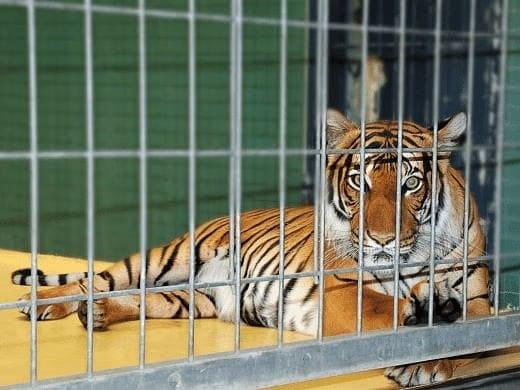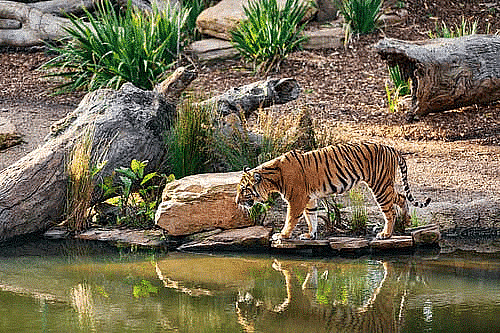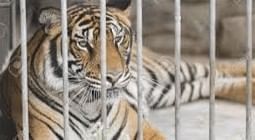Class 10 English Chapter 1 Question Answers - First Flight
Q1: What do you understand by 'His strength behind bars’?
Ans: 'His strength behind bars' refers to the confinement of the tiger's power within the limits of its cage at the zoo. The tiger, locked in a small space, experiences a lack of freedom. This situation leads to feelings of unhappiness, frustration, restlessness, and anger.
Q2: What does the poet convey through the poem?
Ans: The poet highlights the miserable life of animals in the zoo, particularly focusing on the tiger. He contrasts the tiger's existence in captivity with its natural habitat, emphasising that animals have the right to freedom. The poem advocates that these creatures should not be caged but allowed to roam freely in the wild.
Q3: How does the tiger feel in the cage?
Ans: The poet illustrates the tiger's feelings while in the zoo. He continuously moves from one corner to another, as he is confined to a small space. The line, “He stalks in his vivid stripes moving the few steps of his cage,” highlights his frustration. The tiger's behaviour reflects his silent anger and unhappiness.
 Q4: The tiger in the poem ‘A Tiger in the Zoo’ has some obvious limitations, describe them in contrast to its natural habitat.
Q4: The tiger in the poem ‘A Tiger in the Zoo’ has some obvious limitations, describe them in contrast to its natural habitat.
Ans: The tiger in the zoo is confined to a small space, which limits its natural behaviour. It feels frustrated because it cannot move freely, hunt, or engage in its natural instincts. Unlike in the wild, where it would stalk prey and sleep under the stars, the tiger in the zoo is merely a showpiece. The bars of its cage block its view of the night sky, contrasting sharply with the freedom it would experience in its natural habitat.
Q5: What is the theme of the poem?
Or
What message does the poet want to convey through the poem—Tiger in the Zoo’?
Ans: The poet conveys that it is cruel to confine wild animals in small zoo enclosures, far from their natural habitats. These animals experience feelings of anger, helplessness, and unhappiness, as they reminisce about their lives in the forest.
Q6: Why do you think the tiger was stalking in the cage? What does it show?
Ans: I believe the tiger was stalking in its cage due to feelings of restlessness and unease. Confined in such a small space, it likely felt frustrated and helpless, unable to escape and enjoy its natural freedom. The tiger did not want to be merely a showpiece for human entertainment.dom. He did not want to be a mere showpiece and a source of entertainment for human beings.
Q7: Those who deny freedom to others, do not deserve it for themselves. Comment.
Ans: The poem contrasts a tiger in the zoo with one in the wild. The tiger in the zoo is depicted as trapped and restless, moving within the confines of his cage. He stalks in his vivid stripes, taking only a few steps, which reflects his unhappiness and silent anger. In contrast, the tiger in the wild is portrayed as a powerful creature, lurking in the shadows and moving through the long grass near a water hole, where he can hunt freely. The poem highlights the stark difference between the two environments, illustrating how captivity strips the tiger of its natural instincts and freedom. Ultimately, the poem evokes a sense of tragedy for the tiger, as he is confined to a concrete cell, his strength rendered useless behind bars, while he yearns for the wild where he truly belongs.
Q8: Describe the movement of the tiger in the cage and in the wild.
Or
What difference do you find in the mood of a tiger when he is in a zoo and when he is in a forest?
Ans: In the zoo, the tiger is confined to a small cage, which makes him feel unhappy and frustrated. He exhibits signs of restlessness and anger as he paces back and forth. In contrast, in the forest, the tiger moves majestically and freely, enjoying his surroundings. He displays his sharp teeth and claws, instilling fear in nearby villagers. The tiger is truly happy in the wild, relishing his liberty and the natural environment.

Q9: How does the tiger prepare himself for hunting when he is in his natural habitat — the jungle
Ans: The mighty tiger moves stealthily in his natural habitat, the jungle. To prepare for hunting, he knows how to ambush his prey. He patiently waits, hidden in the shadows of trees, and moves silently through the long grass. When he approaches a water hole, he looks for his favourite target—plump deer—ready to strike.
Q10: “Freedom is a birth right. It is the most beautiful gift of god. It is valuable for all human beings as well as for creatures,” Discuss with reference to the poem “A Tiger in the Zoo.”.
Ans: Freedom is the most beautiful gift of god. Freedom is a birthright, without freedom all is in vain. Since the man has come on his earth, he tries to enslave the weaker sections for his own selfishness. If a bird lives in a golden cage, it cannot become happy. It loves to fly freely in an open sky. In the same way, if ‘ a man lives in a prison and gets everything, he cannot feel happiness. But if a man lives freely, he will be happy even in poor conditions. In this poem, we find the descriptions of two tigers, one is in a cage and second in an open field/forest. There is a great contrast between their behaviours.
Q11: How does the tiger terrorise the villagers? Does he have any intention of killing them?
Ans: The tiger often roams freely near the edge of the jungle, approaching the houses of villagers living on the outskirts. As he wanders, he displays his sharp teeth and paws, instilling fear among the villagers. However, he does not intend to kill them; he only attacks when he feels provoked.
Q12: How does the tiger feel locked in the concrete cell of the zoo? Why does he ignore the visitors
Ans: The tiger, a creature of the wild, feels utterly helpless when confined in a concrete cell at the zoo. His natural strength is rendered useless behind bars, leading him to merely pace the length of his cage. He chooses to ignore the visitors who come to see him after purchasing tickets, as he does not wish to be an object of entertainment for others.
Q13: What does the tiger do at night? What does he feel when he stares at the brilliant stars in the sky?
Ans: The patrolling cars move around at night, and the tiger hears their sounds. Although he is locked in a cage, he gazes at the brilliant stars shining in the vast sky. This expansive sky and the shining stars only heighten his sense of helplessness while confined within the cage.

Q14: Read the line below and answer the questions:
He should be snarling around houses
At the jungle’s edge,
Baring his white fangs, his claws,
Terrorising the village!
(a) What does the poet try to suggest through these lines?
Ans: The poet is trying to suggest that the tiger should be allowed to live in his natural habitat.
(b) How does the tiger scare the people?
Ans: The tiger scares the people by growling at them and showing his teeth and claws.
(c) Why does ‘he’ snarl?
Ans: ‘He’ snarls to show his anger and helplessness
(d) How does ‘he’ show his presence?
Ans: ‘He’ shows his presence by snarling, baring his white teeth and claws.
Q15: Read the line below and answer the questions:
He hears the last voice at night,
The patrolling cars,
And stares with his brilliant eyes
At the brilliant stars.
(a) What kind of voices does the tiger hear?
Ans: The tiger hears the voice coming from the patrolling cars at night.
(b) Where does the tiger look at in the night?
Ans: The tiger looks at the brilliant stars shining in the sky at night.
(c) What do you mean by ‘patrolling’?
Ans: ‘Patrolling’ means going around an area at regular times to check that it is safe.
(d) What is the effect of the repeated use of the word ‘brilliant’?
Ans: The repeated use of brilliant shows the contrast. The brilliant stars are free while the brilliant eyes are inside the cage.
|
61 videos|620 docs|69 tests
|
FAQs on Class 10 English Chapter 1 Question Answers - First Flight
| 1. What is the main theme of the poem "A Tiger in the Zoo"? |  |
| 2. How does the poet describe the tiger's behavior in the zoo? |  |
| 3. What emotions does the tiger experience in captivity? |  |
| 4. How does the poem contrast the tiger's life in the wild with its life in the zoo? |  |
| 5. What message does the poet convey about wildlife conservation through this poem? |  |

















